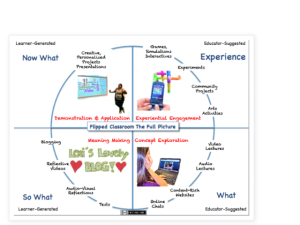It gives me great pleasure to support our curriculum leaders and teachers to achieve our goal of “Using data to inform teaching and enhance learning”. Our latest PD looked at ways to gather data using the “now literacies” of twitter, back channeling and blogs, to name a few. Our curriculum leaders are big ideas people and know other big ideas people so our PD was of exceptional quality. Thanks, @whatedsaid and @langwitches. Each teacher will have got something out of the sessions- depending on their entry point. And based on their responses over the week, I feel they will be able to take the next steps through the sharing and collaboration process that has started to happen from this PD. But more so if leaders in our school manage the tipping point by looking out for and recognising the signs. Even better would be to avoid going over the tipping point altogether by giving the time needed.
I feel that teachers now need time to process and practice what they have learned in this recent PD where for some a big shift in their thinking has started. In our various leadership roles we now need to give teachers the time, space and support to do so without tipping the scales to the point where they feel overwhelmed and stressed and stretched too thin. Sam Sherrat (and others) have stressed the practise of giving time to the things we value. We have got much better at this at our school, but sometimes we can get so enthusiastically caught up in what’s happening that we lose sight of the what else is happening for our teachers. The last two weeks of term are going to be super busy with annual school events in addition to the regular meaningful stuff that needs to get done.
Looking ahead what does our time budget need to allow for?:
*Next term there are Parent Teacher Conference nights at the start of term.
*We are also introducing a new report format to all and this needs some facilitation.
*And we are in the final step of shifting to creating digital portfolios for and of student learning, which for some teachers means big changes.
*Every unit in maths and units of inquiry is new to our new teachers and our inquiry pedagogy is brand new to some.
*Each year level team has at least one new staff member and so are still adjusting to the new dynamics that come with that.
*In addition, teachers are supporting the social and emotional well-being of their students and needing to communicate with parents and do the usual daily essentials.
*In their efforts to lead balanced lives we encourage our teachers to look after their own well-being and our Learning Team Leaders to also look out for their teams’ well-being.
This week I felt it was timely to remind our leaders that if we create the time for ongoing discussions and sharing, more people will be more inclined to take action and embed great practise as a result.
How can we create time to maintain the momentum started in our PD?
*Maybe LTLs can set aside 10 minutes regularly for reading and maybe leaving a comment on our shared teachers “Pictures of Practice” blog or http://www.langwitches.org/blog or whatedsaid.wordpress.com or any other blog teachers have found relevant and engaging.
*I could set aside times in a morning briefing for teachers to briefly share the next step in their journey or a blogpost they have read which has influenced their practice.
*The “now literacies” and the skills needed for embedding them in our teaching and learning practise could be revisited in future PD sessions.
*I welcome more suggestions.
Our teachers want to be the best they can be but we need to set them up for success. By the end of last week some felt close to their tipping point. Excited but also pressured. Tension is good but too much and it can become counter productive.
What ways do you have for managing the tipping point and creating time for your teachers?





